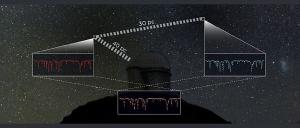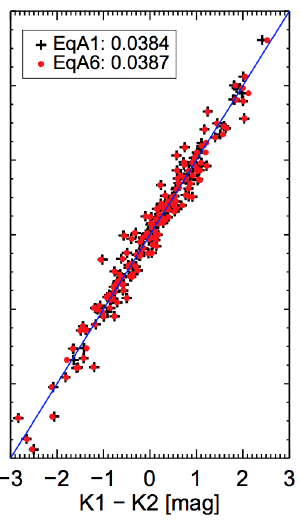Blog
Using Doppelganger Stars
to Measure Stellar Distances
6 September 2015
 Carolina Jofré
Carolina JofréSome of the earliest attempts to measure the distances of the stars was to simply compare their observed brightnesses. By the 1600s it was well established that light obeyed a relation known as the inverse square law, so that closer stars should appear brighter than more distant ones. Specifically, if two stars have the same absolute brightness, but star A is twice as far away as star B, then star A will appear one fourth as bright. Newton and others compared the brightness of the Sun with other stars to estimate stellar distances, but they weren’t very accurate. The problem is that stars can vary significantly in their absolute brightness, and simply comparing stars doesn’t work. Astronomers eventually used other methods such as parallax to measure distances, which eventually led to a range of tools known as the cosmic distance ladder. But now a team has developed a way to determine stellar distances by comparing their brightness, and it’s surprisingly accurate.1
What the team did was to analyze at the spectra of stars looking for stars with extremely similar spectra. They refer to such stars as “stellar twins,” but that term implies these stars have a common origin. These stars didn’t necessarily come from the same stellar nursery, but simply have spectra that make them look quite similar. Basically, they are stellar doppelgangers. If two stars have matching spectra, then their chemical composition and temperature should be remarkably similar. Therefore, the team argues, their absolute brightness must also be quite similar. With similar brightnesses, the old inverse square relation should work for measuring their distances.
 Jofré, et al
Jofré, et alIt’s a great idea, but how could we tell if it works? From the Hipparcos survey we have measured the parallax of about 2.5 million stars, and from the HARPS survey we have measured detailed spectra of many of the same stars. So the team looked for spectroscopic twins in the HARPS data that were also in the Hipparcos data. Using the parallax distance of one twin, they then calculated the distance to the other by the inverse square relation. Comparing their calculated distance to the parallax distance they could determine just how accurate their method is. From the Hipparcos distances, there’s an uncertainty of about 3.5%, so if their method was perfect you’d expect a similar variation in their results. What the team found is that their inverse square method agreed within about 7.5%.
So their method isn’t quite as accurate as parallax, but it has the advantage of not being directly limited by distance. If we can measure an accurate spectra of a star, and it has a twin for which we know the distance, we can determine how far away it is fairly accurately. The method could also be used for stars in open clusters, which are notoriously difficult to measure using parallax. It’s an ingenious method, and one more tool that can we can add to the cosmic distance ladder.
Jofré, P., et al. “Climbing the cosmic ladder with stellar twins.” Monthly Notices of the Royal Astronomical Society 453.2 (2015): 1428-1438. ↩︎